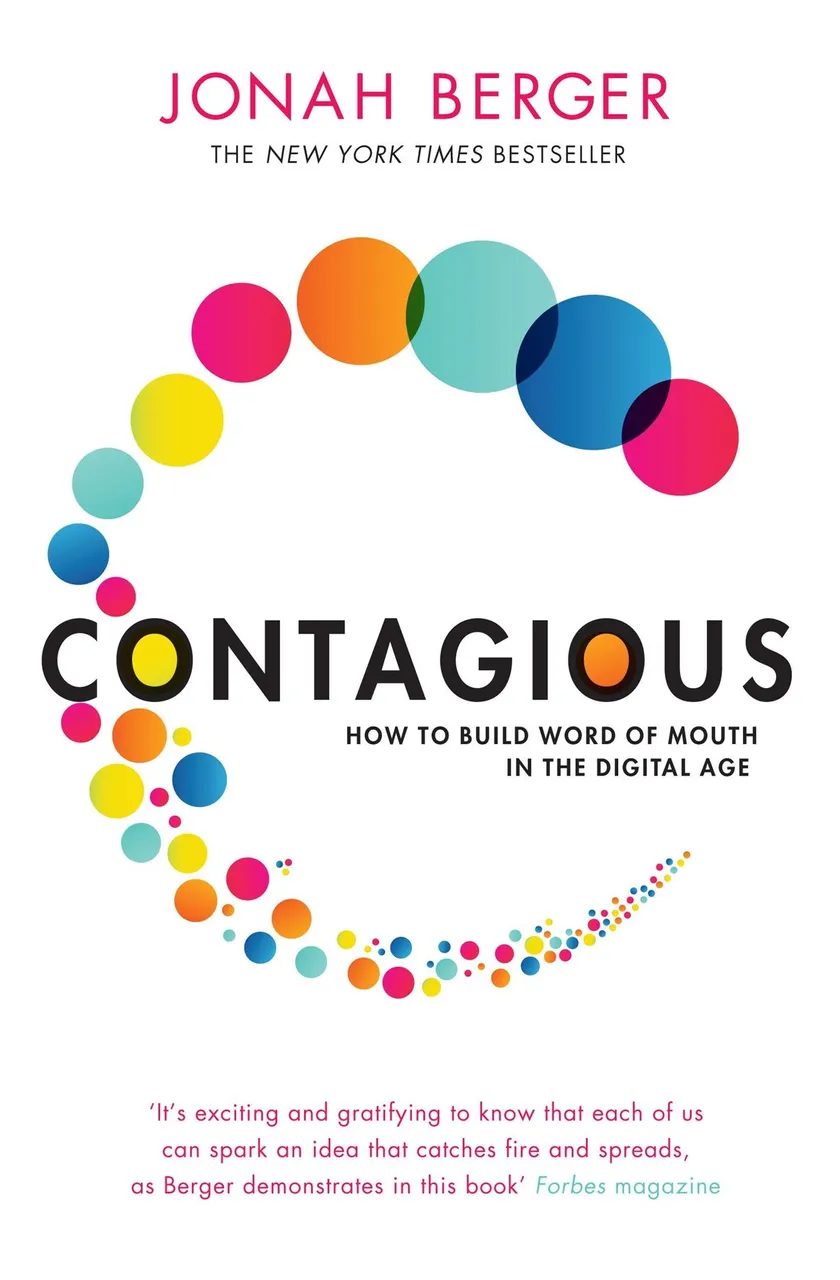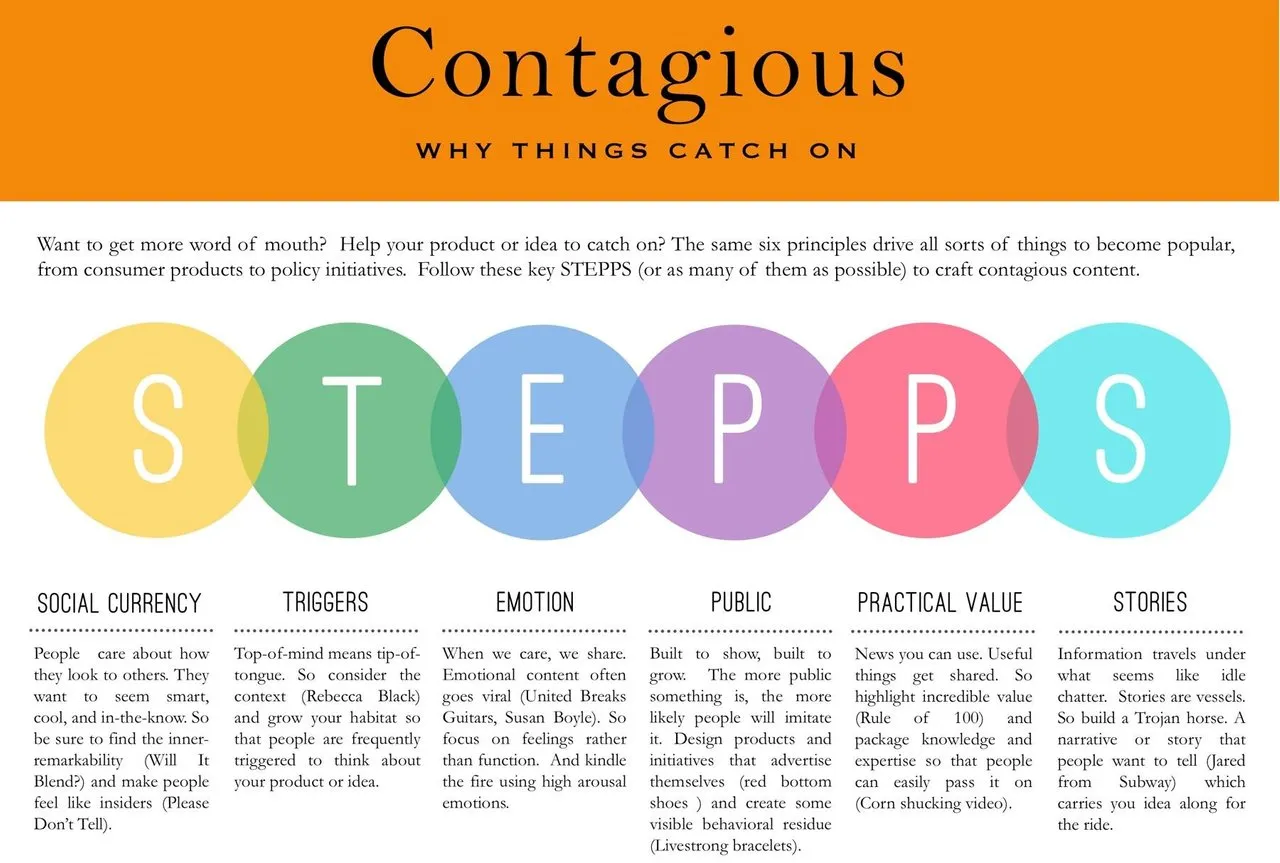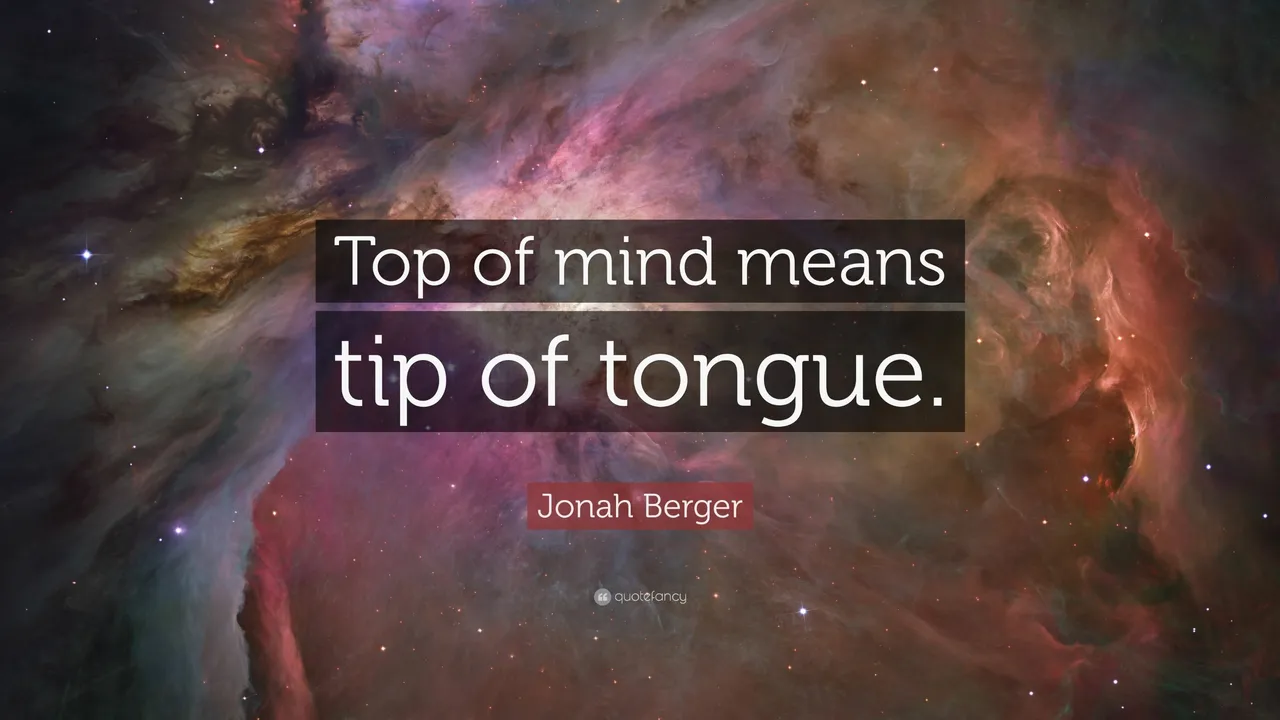"How to build word of mouth in the digital age"

How to get ideas to catch on and spread? That's the key question that gets looked at here, and more specifically how it works and what we can do in the digital realm.
Berger is a professor and author, specialising in word of mouth, social influence, consumer behaviour, and all that good stuff. I must admit I wasn't familiar with the author before this, but I've since realised he's got some great work out there, so will be doing a deeper dive.
As for this book, I ironically got it during the pandemic as the title caught my eye. I think there was an offer on Kindle too and I thought 'all this talk of contagion - it's a sign!' And of course it looked an interesting read.
The book is based around an acronym and 'system' which helps to cement the knowledge and give us a framework to operate from. If we follow these 'stepps' (extra p) then it can take us to where we want to go. Have some, most or even all of these in unison and we should have ourselves a winner.
Without further ado, let's get in amongst it…

Highlights from the book followed by my thoughts…
The Tipping Point
The Tipping Point by Malcolm Gladwell is another great book that treads a similar path. That's where ideas hit that critical point where things take off and really get moving. Here we're trying to tap into that by working the methods so that point is hit and the ideas gain momentum.
@adambarratt/re-leothreads-2ywcfgtug
Made to Stick
Another book referenced by Chip and Dan Heath, Made to Stick is exactly that – what makes ideas survive and thrive, and others fizzle out and go nowhere? Worth reading that in conjunction with this one.
I guess the chief 'difference' is that 'Made to Stick' is about getting ideas started and on the move, whereas 'Contagious' is about them taking off from that point and spreading like wildfire.
There will be similar ideas in each, as well as some fresh material.
@adambarratt/re-leothreads-2g7pfcq8r
STEPPS
Here we are, the framework that we can follow to get those ideas to work. They're all below but for ease of reference:
- Social currency
- Triggers
- Emotion
- Public
- Practical value
- Stories
Principle 1: Social Currency
We kick off with social currency. It's all about people talking about things to make themselves look good, rather than bad and the value that information has when it's shared between individuals.
If people think they will look good, then they want to be associated with it and be the one who shared it as it may lift their social standing.

Principle 2: Triggers
A prompt to think about related things. A cue to think about something associated with what they've just seen or heard.
Organisations need to design products and ideas that are frequently triggered by the environment and create new triggers by linking their products and ideas to prevalent cues in that environment.
As the author likes to say – top of mind leads to tip of tongue!
Principle 3: Emotion
This is an obvious one; get people emotionally invested and they can't help but get involved in some way. Emotions can be very powerful, so if your ideas 'trigger' a strong emotion (whichever end of the scale) then you will be remembered and thought of when the situation arises… for better or worse. That's where motivation comes from, and the stronger the better in this circumstance.
Principle 4: Public
Monkey see, monkey do. Whereas social currency is people talking about your product as they deem it to be good and by association make them look good, 'public' is about copying what's going on around them. 'The sheep factor' as it were. When people see everyone else doing something, then they just have to get involved. And if no-one else is, then they're going to avoid it.
Principle 5: Practical Value
Does the idea, product, service or offer have a practical value attached to it? This isn't always what makes sales (see emotions!) but it does back up a decision with facts and figures.
If you can help someone save time and/or money, make them seem better to others, or help them have a more enjoyable time, then you're adding practical value to their experience.
Principle 6: Stories
The telling of stories is how we've communicated over centuries, and it's still going strong to this day. It just might have changed a bit. In the past, it may well have been the only way to share information, where now that information is everywhere, and at the touch of a button… but we still crave that narrative wrapping it all up.
People are more likely to share if there's a cool, interesting or funny story attached to whatever it is, which is easy to tell and helps make them look like a master raconteur!
Give people a way to make themselves look good while promoting their products and ideas along the way. There are three ways to do that: (1) find inner remarkability; (2) leverage game mechanics; and (3) make people feel like insiders.
That paragraph speaks for itself, and you can find a lot more on this subject from the likes of Seth Godin. Check out Purple Cow for example:
@adambarratt/re-leothreads-wcwnnbbp
One way to generate surprise is by breaking a pattern people have come to expect.
Pattern interrupt. People expect things to go a certain way based on their previous experience. This makes things easy to organise, know what to expect and not get freaked out. If we've seen it all before, it's likely to just be pushed to the background. Interrupt that with something unusual or out of place, and it gets attention.
How you go about that (and the repercussions) is another matter.
Game mechanics are the elements of a game, application, or program—including rules and feedback loops—that make them fun and compelling.
Leverage game mechanics. Knowing how something works and the elements and systems that make it up, allows you to tap into some of that.
People don’t just care about how they are doing, they care about their performance in relation to others.
Are they better than the next guy, that seems more important then actually improving!
Scarcity and exclusivity help products catch on by making them seem more desirable.
Good ol' supply and demand. Scarcity is often used in sales, thus making something more desirable and putting some urgency on the decision and purchase. And if it's exclusive then the same principles apply.
Top of mind means tip of tongue.
As mentioned earlier. Always being in front of people, so you're always top of their mind… which makes them more likely to talk about you and spread your message.

Triggers and cues lead people to talk, choose, and use. Social currency gets people talking, but Triggers keep them talking. Top of mind means tip of tongue.
This sums up the process of these principles working together and how they feed on to one another.
Rather than harping on features or facts, we need to focus on feelings; the underlying emotions that motivate people to action.
Sell the sizzle not the steak. People buy with their emotions and then justify with facts. Those emotions are what will be the driver, then all the features just need to stack up so as not to give them a reason not to buy/share etc.
Rule of 100
When offering statistics or pricing. If a product's price is less than $100, the Rule of 100 says that percentage discounts will seem larger and if it's over 100 then the actual amount saved is more impressive.
Thanks Jonah! Anything Else?
A really interesting and worthwhile book on getting ideas to spread. Some great background on the psychology as well as practical tips.
The STEPPS framework is a very handy reference as you can hold up any idea to that structure and see where it hits, and where it misses. You can then tweak whatever it is to suit these principles and add impetus to your offerings.
Check out those other books mentioned in the highlights section and perhaps some more of Jonah's work as I intend to do.
Worth a read for all, especially if you're looking for tips on being 'top of mind and tip of tongue'!
Video review:
@adambarratt/re-leothreads-2rlrrad2p
First image my own, others linked to source